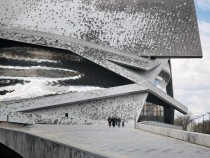
© Frank Kaltenbach
The success and acceptance of stage structures no longer depend on acoustics alone nor on the quality of a grand auditorium. A decisive factor is a smooth transition, without barriers, to the city or the landscape outside, so that people are attracted quite naturally to a building – beneath it, on top of it or, of course, inside it.
The Berlin Philharmonic Hall, which opened in 1963, is still an iconic stage structure. By arranging the audience around the orchestra, Hans Scharoun created the typology of the vineyard. Would this masterpiece of architecture and acoustics still have a chance of being implemented today, however? The building has one clear deficit: it stands aloof from the public realm and fails to communicate with it.
Modern stage structures, it would seem, can no longer afford such an exclusive stance. The theme today is inclusiveness – not just of an elite that actually attends the performances within, but of the whole of urban society. This increases the quality of life in the public realm, and there is also greater acceptance of what are often considerable public investments.
The Berlin Philharmonic Hall, which opened in 1963, is still an iconic stage structure. By arranging the audience around the orchestra, Hans Scharoun created the typology of the vineyard. Would this masterpiece of architecture and acoustics still have a chance of being implemented today, however? The building has one clear deficit: it stands aloof from the public realm and fails to communicate with it.
Modern stage structures, it would seem, can no longer afford such an exclusive stance. The theme today is inclusiveness – not just of an elite that actually attends the performances within, but of the whole of urban society. This increases the quality of life in the public realm, and there is also greater acceptance of what are often considerable public investments.








